In my last post, I mentioned that one of my favorite things I’ve written on this blog has been a series about the 2014 movie, Maleficent, despite my having-at best-a very mixed opinion on it. I published it to coincide with Halloween since it was about an iconic villain, so for this Halloween I thought I’d do another series about an iconic villainess from a Disney animated movie who has inspired many a Halloween costume. But instead of just looking at the spinoff movie she recently got, I’m going to be reviewing each of the four released movies that feature Cruella De Vil. I don’t think any of them are as interesting as Maleficent[1]Which isn’t to say they’re all inferior to it. Oh no! I make a distinction between interesting and good. but the lore of 101 Dalmatians can be surprisingly crazy. Or maybe not so surprising when you stop to think about how kooky the original story really was.
The Devil Appears: One Hundred and One Dalmatians (1961)
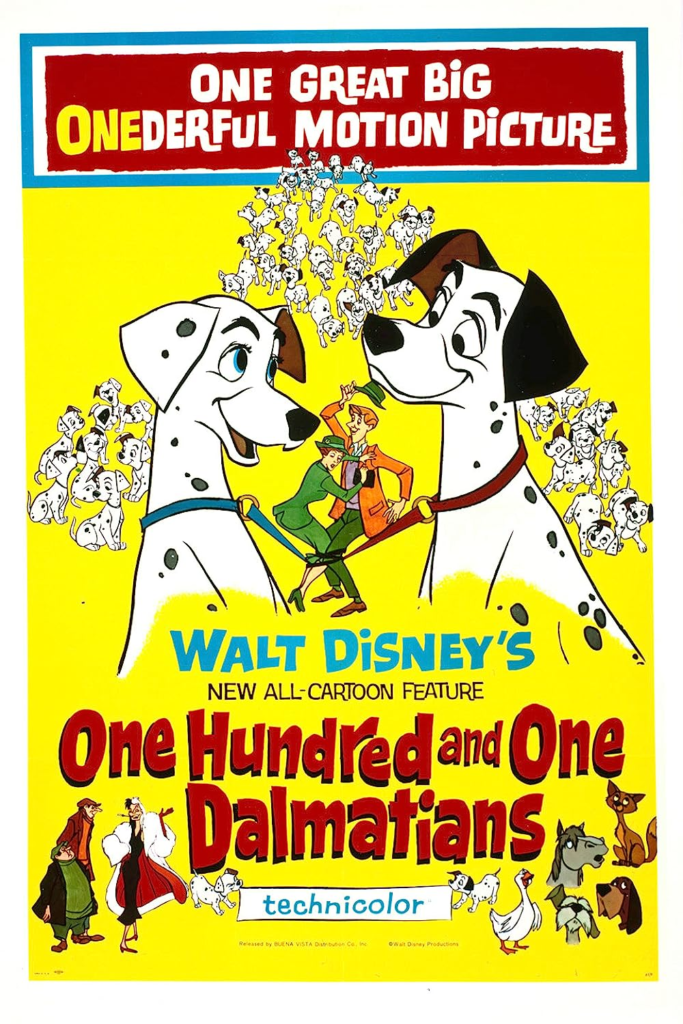
This is one of those movies adaptations which I can sum up by saying, “it’s OK but the book is better.” I know that’s kind of a cliche and there are lovers of movies and television out there who roll their eyes whenever they hear it but…it’s true! It’s not that I consider the 1961 animated movie terrible or anything. It’s quite cute. But the 1956 book, The Hundred and One Dalmatians by Dodie Smith, was also cute while also being much more interesting. Still, I’ll try to give this adaptation its due.
This movie starts out with a really fun opening credits scene.
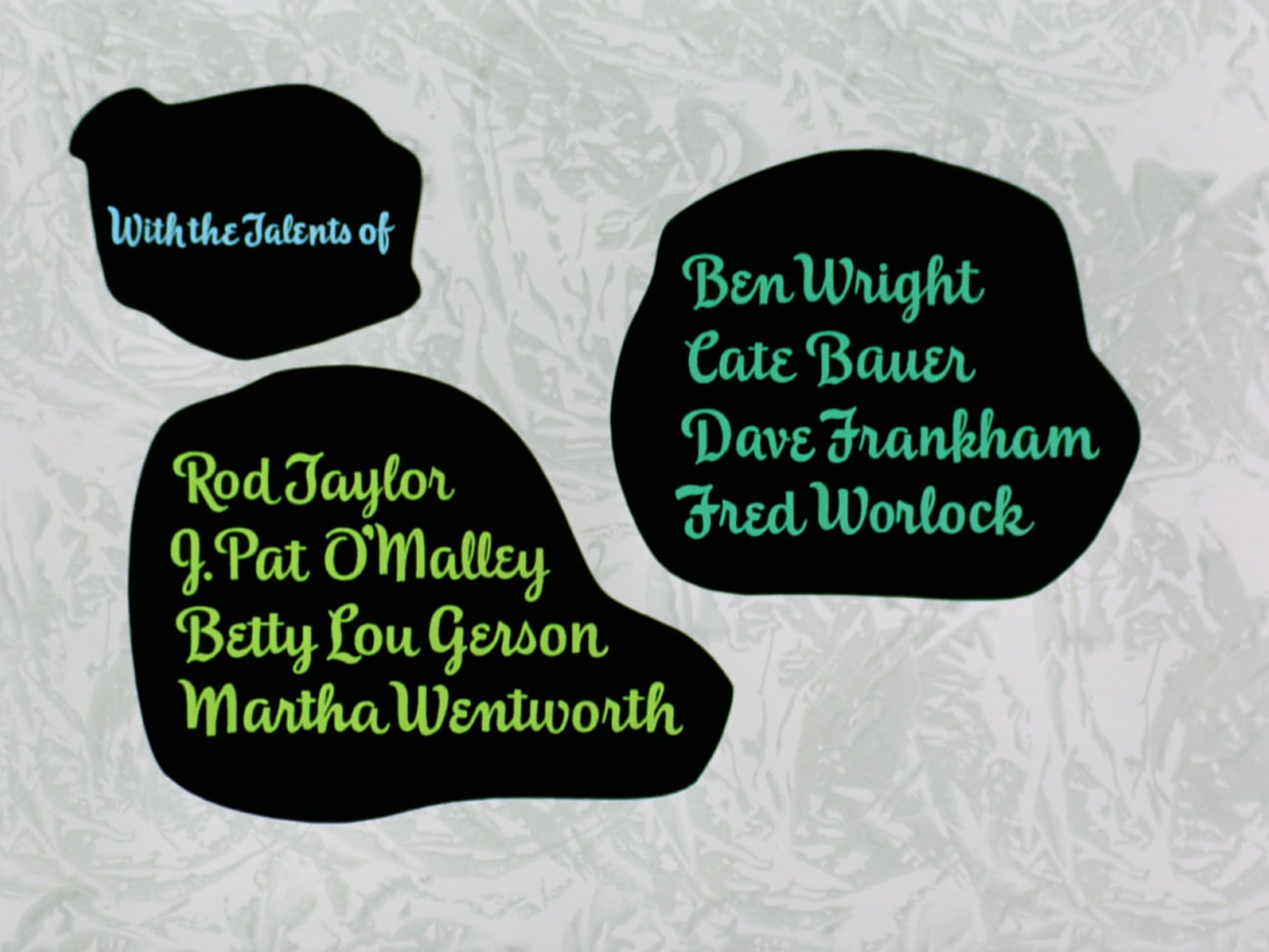
In general, the visual style for the whole thing is fun. The backgrounds have a much more sketchy, “modern” look than those from most of the Disney animated movies that had come before.[2]The animators were also using a new technology called xerox. I wouldn’t get into it because I’m not a technology guy, but it might be worth a google if you’re interested. I don’t love the look per se, but I think it works for this movie.


The character designs are also much more caricatured and cartoony than typical for Disney heretofore. They’re great. Pongo (voiced by Rod Taylor), the lead dalmatian, and his “pet,” Roger Radcliffe (Ben Wright), are especially fun to watch.



The leading ladies, dalmatian love interest Perdita (Cate Bauer) and her “pet,” Anita (Lisa Davis), are, perhaps predictably, more conventionally pretty. But if you compare Anita to Snow White, Cinderella or Sleeping Beauty, she still has something of an appealing everywoman quality to her.


Despite what I wrote about the book being better, I should stress that this isn’t a horribly inaccurate adaptation of it. Mind you, it’s not beat-for-beat accurate but considering Disney’s reputation for bad adaptations, it’s remarkably faithful.[3]You could argue that it’s Hollywood in general that makes bad adaptations and Disney just makes for a convenient scapegoat but never mind. It stays true to the book’s premise, its broad characterizations and overall spirit. A number of the movie’s most charming ideas come from the source material, like the dogs thinking of their human owners as pets or dogs barking late at night actually being a sophisticated chain of communication. In a few cases, it even takes ideas from the book and improves upon them. The game show, What’s My Crime, and the villainous Baddun brothers, Horace[4]Who was named Saul in the book by the way. (Fred Worlock) and Jasper (Disney veteran J. Pat O’ Malley), being so absorbed in watching it that they don’t notice the multitudinous puppies they’re supposed to skin sneaking out of the room are from Dodie Smith. But the movie makes of this a great little suspense scene with the show’s contestants’ desperation to make the right guess before time runs out paralleling Sgt. Tibbs the cat (David Frankham)’s desperation to herd every puppy out before the episode is over. The book also has the dalmatians rolling in soot to disguise themselves but only in the movie do they have to sneak past the villains this way in another nifty bit of suspense.

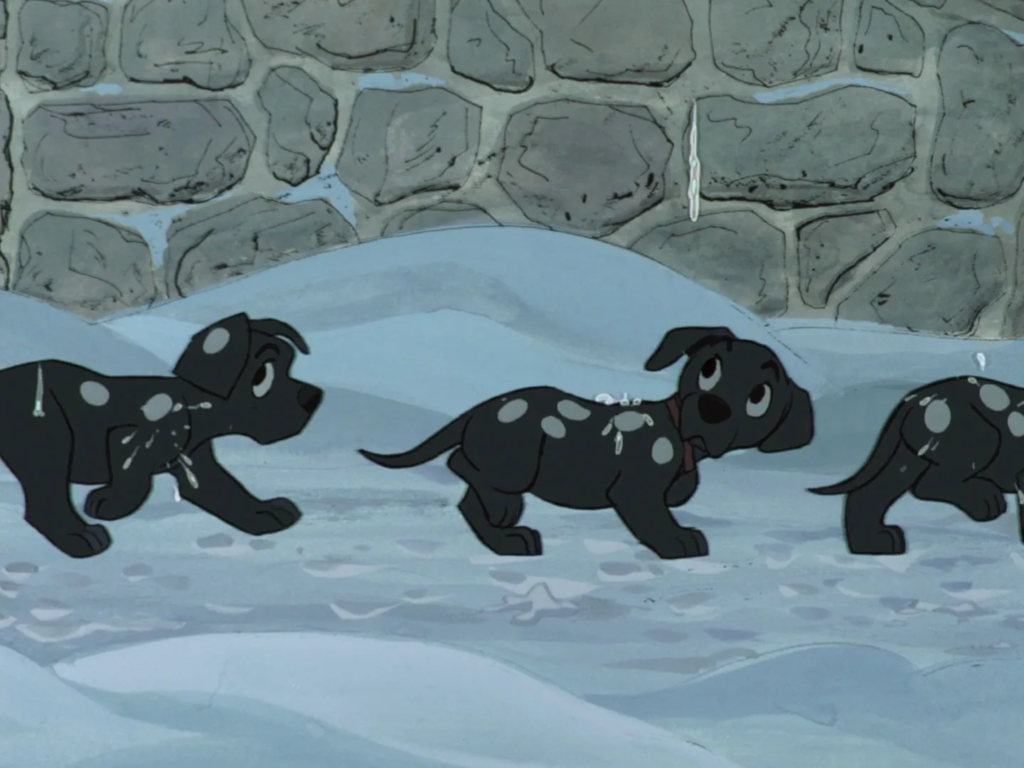
I hate to admit it, but the characters of Roger and Anita are probably more endearing than their literary counterparts, Mr. and Mrs. Dearly. The book opened with both the dalmatians and their “pets” happily married, which I think works fine there, but I agree with Disney story man Bill Pete that it would have been a dull way to open the movie. The initially disastrous meeting between Roger and Anita that turns out surprisingly well is great fun and the two of them have nice chemistry. Mr. Dearly in the book is a financial wizard who “had done the Government a great service (something to do with getting rid of the National Debt) and, as a reward, had been let off his Income Tax for life.” (It’s that kind of book.) Roger in the movie, on the other hand, is a struggling musician. Him being rich made it more semi believable that he and his wife could keep seventeen dalmatians and later a hundred and one. But the Radcliffes’ modest means draw viewers’ sympathy and interest and Roger being a musician leads to the soundtrack having a nice jazzy vibe.

In the book, the couple had two servants, Nanny Butler who was Mr. Dearly’s nanny growing up and eventually became his butler and Nanny Cook who was Mrs. Dearly’s nanny growing up and eventually became her cook. The movie combines them into one character, Nanny (Martha Wentworth), who fulfills both functions. This is understandable from a practical standpoint, but I’ve got to say the only really memorable thing about the nannies from the book was the joke of their names and Nanny Butler taking on a traditionally masculine job. Without those things, the movie’s Nanny lacks any kind of gimmick.
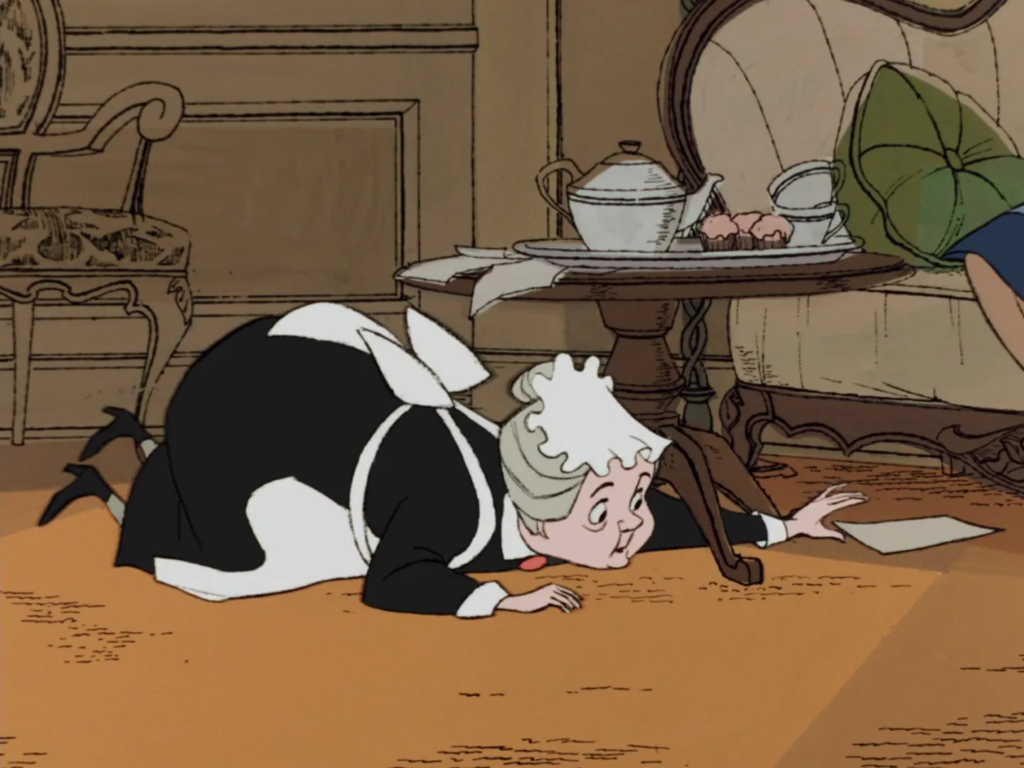
The movie’s Perdita is also a combination of two characters from the book. In Dodie Smith’s version, Pongo’s mate was named Missus Pongo and Perdita was the name of a stray dalmatian who had lost her puppies[5]Guess how. and whom the Dearlys took in to help nurse their dogs’ litter of fifteen. Again, this is understandable from a practical standpoint. Having the mother dalmatian just be called Missus was pretty lame. Perdita doesn’t do much in the book besides help nurse the puppies and developing her in the movie would have slowed down the pace. But this change reflects the absence of one of the most endearing things about the literary Hundred and One Dalmatians: its surprising streak of realism. (I said, streak of realism, not a lot of realism.) Not only does the book insist that a single mother dog would have a hard time nursing fifteen puppies by herself, it also has the humans keep Pongo from away from Missus after she gives birth because “mother dogs did not usually Like to have father dogs around when puppies had just been born.” It also has them try to keep Missus and Perdita and the puppies that each nurses apart on the grounds that Missus would hurt her children that she didn’t recognize, and she and Perdita would fight though this turns out to be unwarranted.
…this does happen with some dogs. It would never have happened with Missis, but it will already have been seen that she and Pongo were rather unusual dogs. And so was Perdita. And so, if people only realized it, are many dogs. In fact, usual dogs are really more unusual than unusual dogs.
Perhaps a Disney movie was never going to reference the brutalities of nature in this way even to avert them. But in doing so it loses the sense you get from the book of a real fondness for and interest in dogs and animals in general.

The reason I wished to write about this movie during October was because Cruella De Vil (Betty Lou Gerson) is an iconic villain, wasn’t it? Well, as I said, she’s an icon. The movie’s design stays fairly true to the book’s description of her as tall, dark and sporting that trademark half black, half white hairdo. Her nose is less pointed and more piglike though and rather than the “absolutely simple white mink coat” she wears in the book, she has a giant poofy one that contrasts amusingly with her ridiculously bony body. I don’t mean that as a criticism, for the record, it’s a very fun character design.
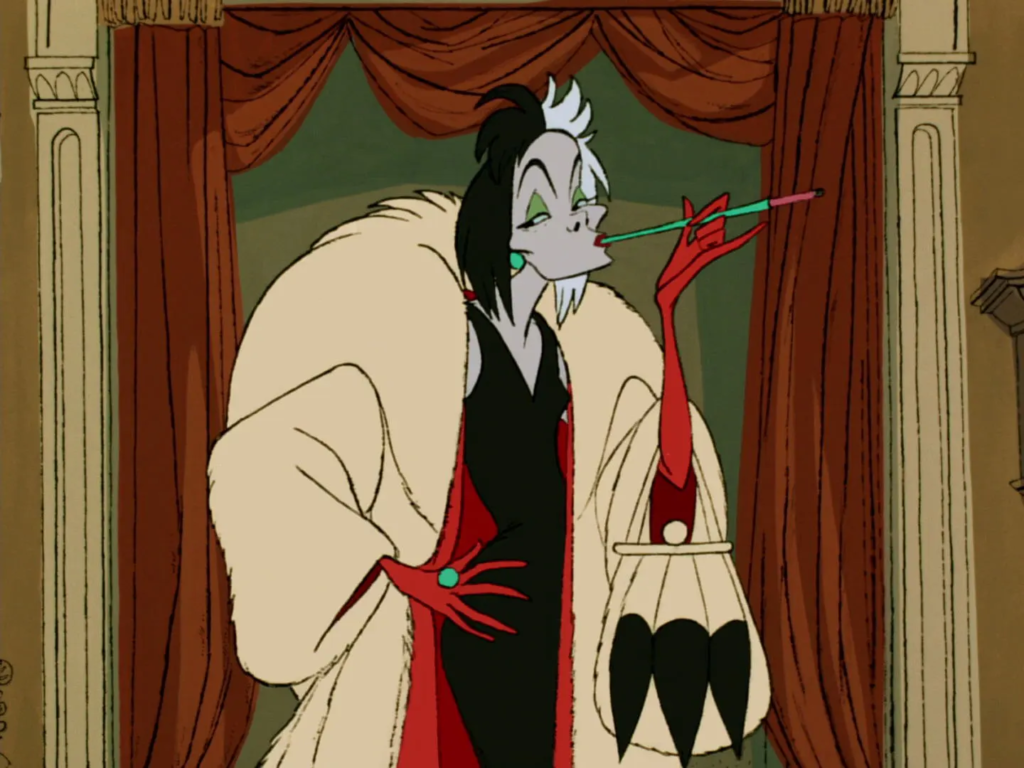
I also like a moment the adaptation invents where Pongo tries to evade her detection by erasing his family’s pawprints with a stick and she sees right through it. Villains who are played for laughs but are also somewhat competent and represent legitimate threats interest me.[6]Disney animation has created more than a few. There’s also Captain Hook from Peter Pan and Kaa the python from The Jungle Book. Even Yzma from The Emperor’s New Groove surprisingly has … Continue reading But while I don’t imagine the book’s Cruella as being as hammy and scenery chewing as the one in the movie, Disney actually makes her a less outlandish and over the top character than that one. For one thing, we never see her eating black pepper-flavored ice cream.[7]All Cruella’s food tastes like pepper in the book. Maybe she’s related to the Duchess of Wonderland’s cook. For another, Cruella’s surname isn’t just a joke in the book.[8]And it’s spelled with a small d but, hey, who’s keeping track? It’s actually implied that she’s actually a descendant or some distant relative of Satan. That’s what Pongo comes to believe anyway, and he’s described as possessing “one if the keenest brains in Dogdom.” I wonder why Disney didn’t go with that since they were no strangers to supernatural antagonists. It’s also worth mentioning that while Cruella doesn’t get her coveted dalmatian fur coat and her fancy car is utterly destroyed, she doesn’t get nearly as much comeuppance as she does in the book.[9]The car isn’t destroyed in the book but…well, let’s just say some other possessions of her are. It’s not even clear if the Radcliffes ever know for sure that’s she the one who stole their dogs. Perhaps to make up for this, future 101 Dalmatians movies would devote so much time to humiliating Cruella that it would get tedious, but we’ll get to that later.
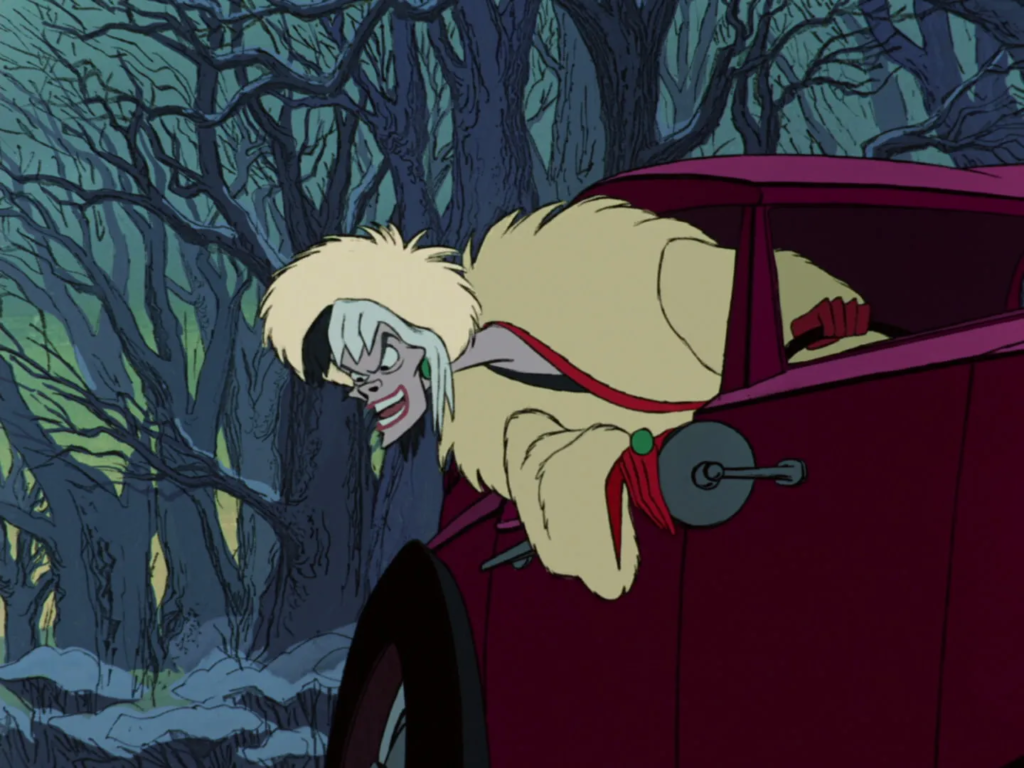
Cruella’s ultimate comeuppance isn’t the only memorable scene from the book’s second half that would be cut. We also lose the touching scene of Pongo and Missus encountering an old man who thinks they’re the ghosts of dogs he knew in his childhood and the character of Tommy Tompkins, a human toddler who, not having mastered English yet, can communicate to an extent with dogs and helps them out. (He serves as a foil to another little boy Pongo and Missus meet who throws stones at them.) The book also has some odd use of Christian imagery. Not only is the main villain associated with Hell and the Devil but at one point, the dogs find sanctuary in a church building with a nativity set in it, which they find by following a star on Christmas Eve. Missus has previously resented churches since dogs aren’t allowed in them but changes her mind after this positive experience. Her “pet” is reported as saying that she herself would go to church more if dogs were allowed inside. I don’t know much about Dodie Smith, but the book gives the impression that she found Christianity-or Christian imagery anyway-attractive but disliked that it didn’t provide any afterlife for dogs.[10]The protagonists of a later children’s book she’d write, The Midnight Kittens, would be an atheist and an agnostic, though not militant ones, which presumably reflects her own beliefs at … Continue reading Not much later in the book, the dalmatians are in a tight spot and Pongo declares that nothing but a miracle can save them. Just then, a van appears on the scene, providing their escape and leading Missus to think that type of vehicle is called a miracle.[11]Missus in the book is a lot ditzier than Perdita in the movie but on the flipside, she’s much more resilient. None of this makes it into the movie.[12]Well, there is a van, but it isn’t called a miracle.
On the whole, I’d describe this movie as like the book with most of the most interesting parts removed. Because of that, I really can’t say it’s a good adaptation, but I can’t say it’s a terrible one either. There’s still plenty of charm to be found in it if you’re a member of the target audience and it probably helps if you have a higher tolerance for the sound of dogs barking than I have.
The Devil Is in the Details: 101 Dalmatians (1996)

This 1996 live action remake of the old, animated film really doesn’t do itself any favors by opening with a very dull opening credits scene that shows up poorly beside the visually entertaining one in the original.

The soundtrack by Michael Kamen is also, to my ears anyway, annoyingly heavy-handed compared to the more pleasant one from the 1961 version. But let’s not get too negative too soon.
This remake portrays Roger (Jack Daniels) as a struggling video game designer rather than a struggling songwriter. Hmm, maybe we do need to get really negative right away. I don’t get this change. Struggling songwriter just strikes me as more romantic than struggling video game designer, an irrational prejudice on my part perhaps. I don’t see the point of the career change, but it doesn’t ruin the character or the movie for me. Anita (Joely Richardson) now works for Cruella De Vil (Glenn Close)’s fashion company. This, by the way, arguably harkens back to the book where Cruella was married to a furrier and intended to sell Dalmatian fur coats as well as own one.[13]Roger’s surname is also Dearly as in the book, and I think the ultimate fate of the country home where Cruella stashes the puppies might be the same as in it too. I’m not quite sure … Continue reading Instead of inspiring Roger to write a song that makes enough money for the family to move to the country and keep over a hundred dalmatians, Cruella serves as the model for the villain of his latest video game. Normally, I’d avoid giving that plot point away, but the movie foreshadows it in such a deliberate, even cheeky way that I’m convinced viewers are expected to guess it.
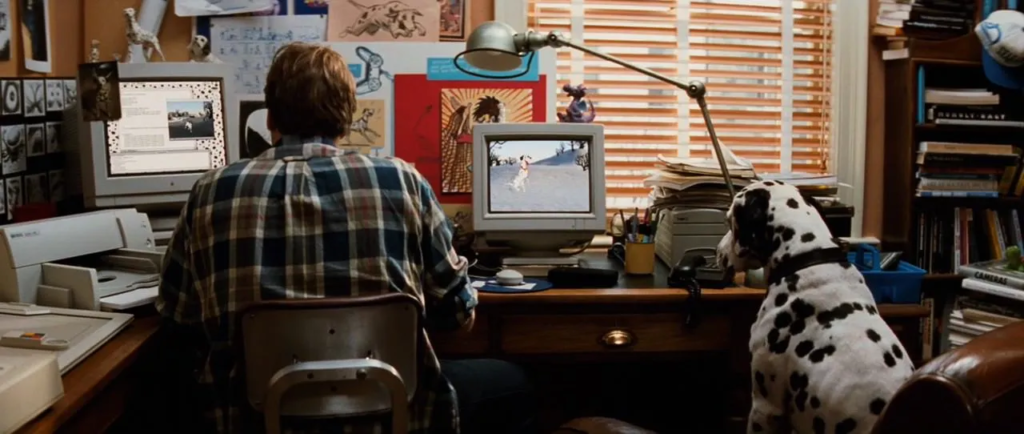
A startling thing about this film is its implied antifeminist message. Cruella expresses displeasure at Anita wishing to quit her job once she gets married and settles down, saying, “More good women have been lost to marriage than to war, famine, disease and disaster. You have talent, darling. Don’t squander it.”[14]Whatever one’s views on gender, I’m really not sure what selfish motive Cruella could have for saying this. Presumably, she doesn’t want to lose a valuable employee, but the movie … Continue reading She also disapproves of Anita’s desire for children, saying coldly that she has “no use for babies” as opposed to puppies. Presumably, since Cruella in the 1961 movie looked down on Anita for marrying someone who wasn’t wealthy, the filmmakers thought the closest modern equivalent would be her looking down on her for pursuing a family over a career, but the result is this remake actually feels more offensive to modern sensibilities than the older original. It’s actually Anita having a job that gives Cruella the idea for a dalmatian fur coat in the first place, setting the conflict in motion.
The biggest difference between this movie and the old one is that the dogs don’t talk and neither do any of the other animal characters. This works fine, though not brilliantly, during the movie’s first half or so where Pongo and Perdita just have to convey basic emotions like attraction to each other, distrust of Cruella and concern for their puppies. But once the big rescue mission kicks off with all of its communication between species, the animals not talking starts to feel weirder than having them talk would.
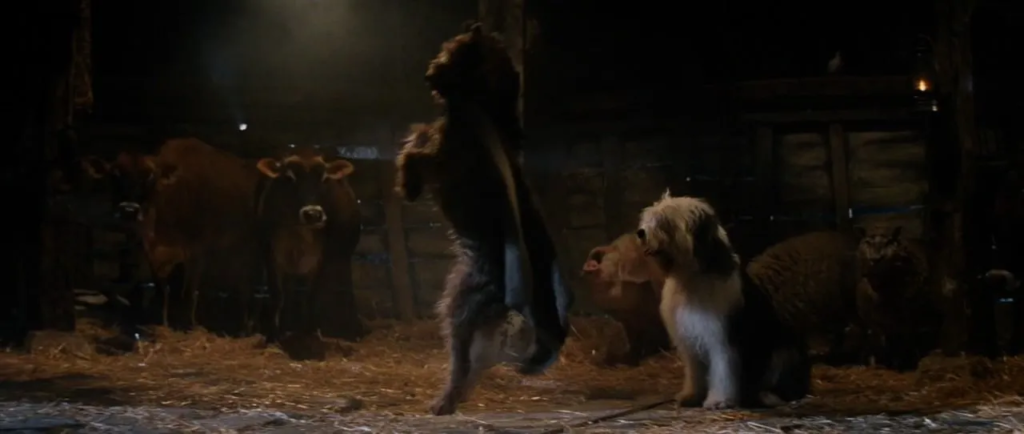
The movie’s live action dalmatians, while very well trained, also completely lack the highly expressive faces of their 1961 animated counterparts.[15]It’s disheartening to remember that this came out a year after the family classic, Babe, which got such great dramatic performances out of border collies. This means that the movie’s second half focuses largely on noncharacters, and it really drags after a while.

That’s too bad because the first half or so is actually fairly promising. As long as it sticks to verbal comedy rather than physical, the script by John Hughes is quite funny and quotable. Daniels and especially Richardson are charming as Roger and Anita and the film does a just good enough job of establishing a fairy tale atmosphere to sell their incredibly fast romance. (I always assumed that in the animated version they dated for a while offscreen between the day they met and their wedding. Here Roger lets slip a proposal that very evening!) Joan Plowright is also adorable, if I can use that word without sounding condescending, as Nanny.

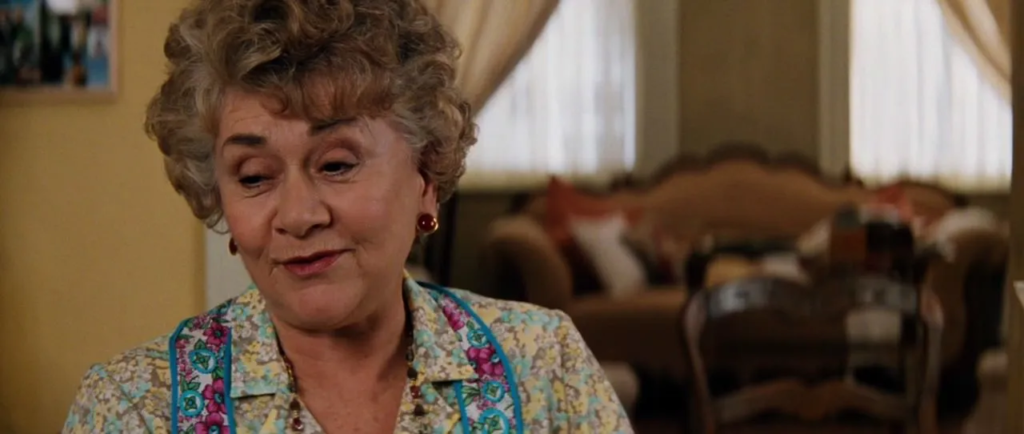
The most popular character from the original movie-the only popular character, truth be told, was easily Cruella De Vil and this one clearly sets her up to be the biggest thing in it too. The design team went to town with the cartoony stylizations of her wardrobe, workplace and house with their emphasis on black, white and red.
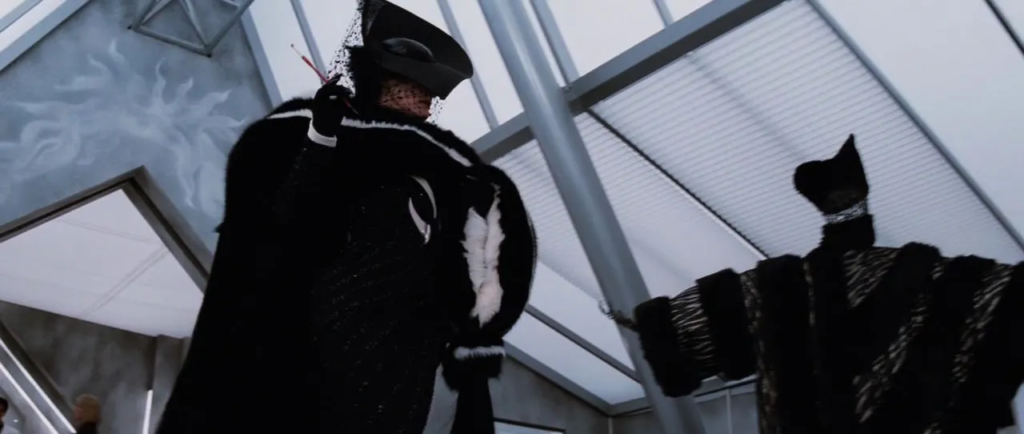
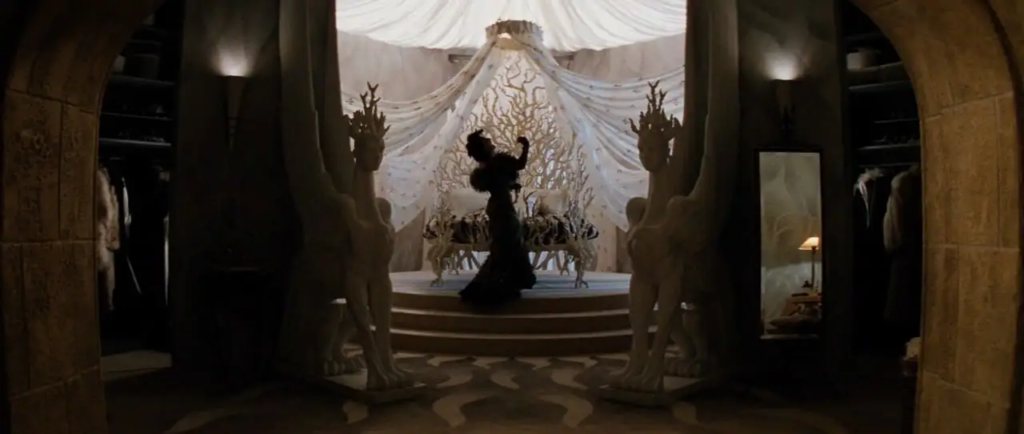
The script includes all of her most memorable lines from the 1961 movie and invents some good new ones too. “My faith in your limited intelligence is momentarily restored,” she tells her employees at one point. Later, she taunts her animal adversaries by saying, “you’ve won the battle but I’m about to win the wardrobe!” Many would cite Glenn Close’s performance as the best thing or the only good thing about the movie but I’m really not a fan. If you compare any of her readings of the character’s classic lines with those of Betty Lou Gerson, they sound flat by comparison. Her attempts to mimic the cartoon character’s body language, such as the strange way she holds her fingers as if always clutching something, just strike me as awkward. When this Cruella is restrained, she comes across as stiff and when she shrieks or cackles, she comes across as less entertainingly hammy and more…like a genuinely disturbing portrayal of an unhinged maniac.
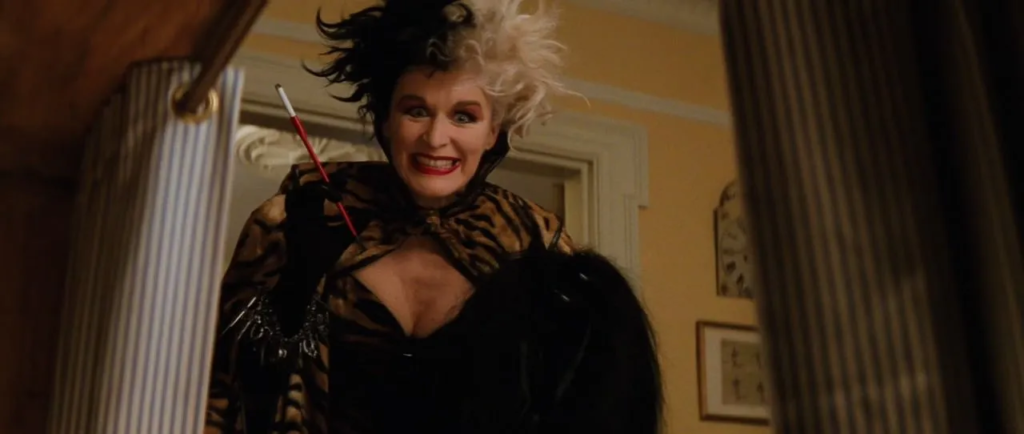
This weird tonal problem with Cruella arguably extends to the whole film. At times, it seems like it wants to be a slightly darker and edgier take on the story.[16]It’s rated PG rather than G though I’m not entirely sure why. In addition to the comedic Horace (Mark Williams) and Jasper (Hugh Laurie), Cruella has another sidekick, Skinner (John Shrapnel), who skins the animals she steals for her fashion purposes. Skinner never speaks owing to having (reportedly) had his throat torn out by a dog in his youth, leaving him with a very noticeable scar. This is at least potentially creepy as well as ridiculously over the top.
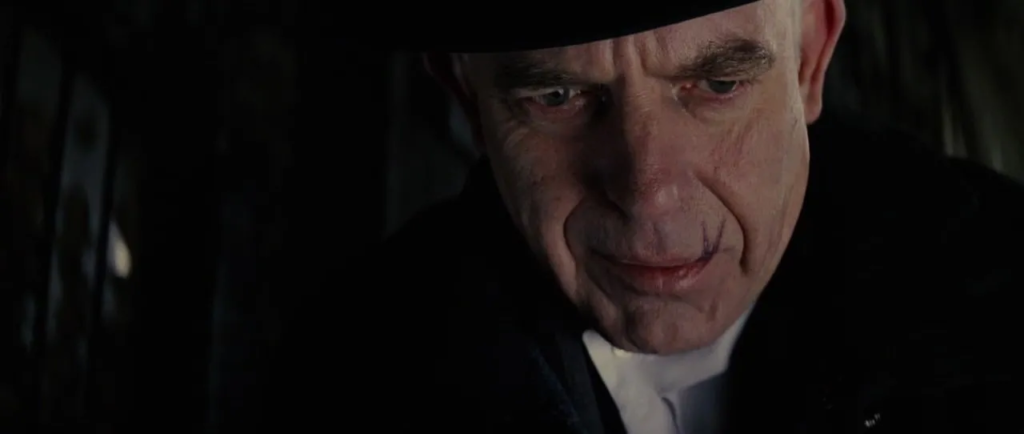
Jasper and Horace overpowering Nanny and locking her up so they can steal the puppies is also potentially more disturbing here though that may just be due to the change of medium.[17]It’s still played somewhat for laughs in the live action version as she still puts up a good fight and you could argue it was always a little bit disturbing in the animated one. On the other hand, the movie’s second half swaps the suspense of the original for slapstick comedy as it turns into a series of scenes of the villains being easily outwitted and outmaneuvered by various animals. (Apparently, nobody informed the filmmakers that raccoons aren’t native to England.) There was already plenty of slapstick violence in the 1961 movie but this one seems determined to outdo it. It certainly outdoes it in terms of outrageousness as Jasper and Horace’s crotches get electrocuted and Cruella gets squashed by a giant hog but not in terms of actually being funny. Slapstick can be really funny in my experience, but this movie’s cartoony violence is the kind of thing that you’ll love as a kid and then look back on as an adult and think, “man, was I stupid at that age!”[18]The remake also dials up the slapstick of Roger and Anita’s meeting from the old movie. It’s not that funny either but thankfully it’s not as obnoxious. Ironically, if it were animated instead of live action, it would probably work better. You can tell this was made by a post-Home Alone John Hughes and I don’t mean that as a compliment. The second half just drags on and on, refusing to leave poor Cruella with any dignity, and it sours the whole viewing experience.
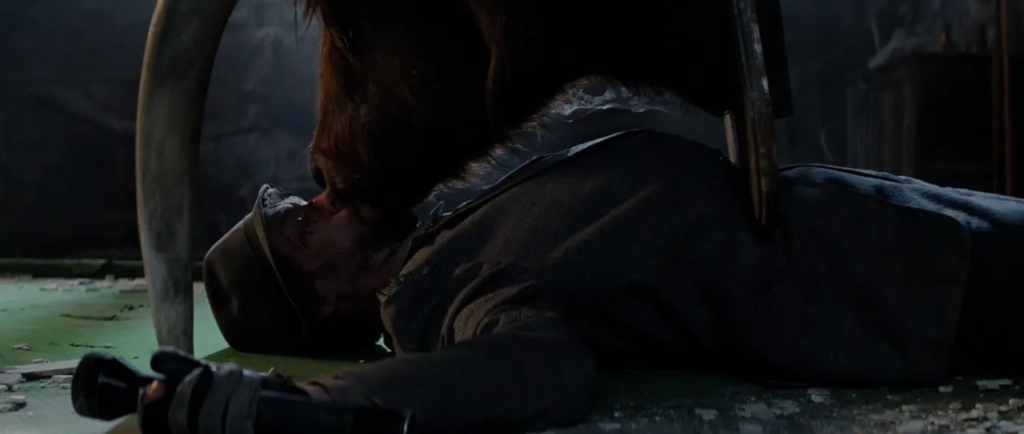

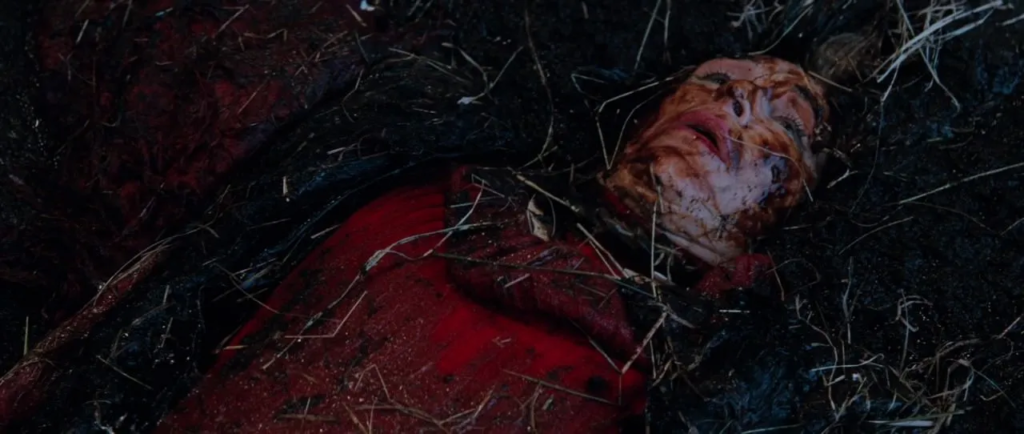
Which is too bad because I really am fond of that first half even if there’s nothing in it worth replacing the original movie. Hey, who said it has to replace the original? If you read this blog at all, you’ll soon find that I’m the kind of guy who likes to hear the same story told by as many different people as possible, even if some of those storytellers are superior to others. I feel towards this remake as a teacher might feel toward a basically smart, underperforming, occasionally obnoxious pupil who could do so much better if only they would apply themself.
Next Week on The Adaptation Station.com: Attempts are Made to Rehabilitate Cruella
References
| ↑1 | Which isn’t to say they’re all inferior to it. Oh no! I make a distinction between interesting and good. |
|---|---|
| ↑2 | The animators were also using a new technology called xerox. I wouldn’t get into it because I’m not a technology guy, but it might be worth a google if you’re interested. |
| ↑3 | You could argue that it’s Hollywood in general that makes bad adaptations and Disney just makes for a convenient scapegoat but never mind. |
| ↑4 | Who was named Saul in the book by the way. |
| ↑5 | Guess how. |
| ↑6 | Disney animation has created more than a few. There’s also Captain Hook from Peter Pan and Kaa the python from The Jungle Book. Even Yzma from The Emperor’s New Groove surprisingly has her moments. Even more surprisingly, so does Kronk. |
| ↑7 | All Cruella’s food tastes like pepper in the book. Maybe she’s related to the Duchess of Wonderland’s cook. |
| ↑8 | And it’s spelled with a small d but, hey, who’s keeping track? |
| ↑9 | The car isn’t destroyed in the book but…well, let’s just say some other possessions of her are. |
| ↑10 | The protagonists of a later children’s book she’d write, The Midnight Kittens, would be an atheist and an agnostic, though not militant ones, which presumably reflects her own beliefs at the time. But you wouldn’t guess that from The Hundred and One Dalmatians. |
| ↑11 | Missus in the book is a lot ditzier than Perdita in the movie but on the flipside, she’s much more resilient. |
| ↑12 | Well, there is a van, but it isn’t called a miracle. |
| ↑13 | Roger’s surname is also Dearly as in the book, and I think the ultimate fate of the country home where Cruella stashes the puppies might be the same as in it too. I’m not quite sure though. There’s also a veterinarian in the movie named Tomkins, which I’d like to believe is an homage to the character of Tommy Tompkins from the book. It’s probably just a coincidence though. |
| ↑14 | Whatever one’s views on gender, I’m really not sure what selfish motive Cruella could have for saying this. Presumably, she doesn’t want to lose a valuable employee, but the movie establishes that Anita still sends her sketches from home. “It’s not the same thing,” insists Cruella, “I miss the interaction.” |
| ↑15 | It’s disheartening to remember that this came out a year after the family classic, Babe, which got such great dramatic performances out of border collies. |
| ↑16 | It’s rated PG rather than G though I’m not entirely sure why. |
| ↑17 | It’s still played somewhat for laughs in the live action version as she still puts up a good fight and you could argue it was always a little bit disturbing in the animated one. |
| ↑18 | The remake also dials up the slapstick of Roger and Anita’s meeting from the old movie. It’s not that funny either but thankfully it’s not as obnoxious. |
